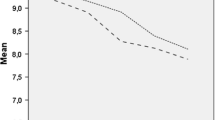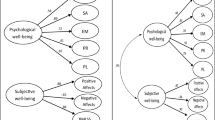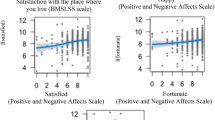Abstract
This article presents the results of a one-year follow-up study on a sample of 940 adolescents, in which participants have been classified according to the changes they have experienced in their subjective well-being (SWB), measured by means of two different single-item scales (overall life satisfaction –OLS– and happiness overall –HOL). A range of multinomial logistic regression models were employed to determine which factors lead to such differences. Results show that when OLS is considered, the factor most contributing to an increase in SWB is family self-concept, while the one most contributing to its decrease is satisfaction with the family. When HOL is taken as the dependent variable, the most important factor in predicting an increase in SWB is being valued in the future according to the amount of money I have, with life optimism being the most important factor in predicting its decrease. Only three indicators (the importance of being valued in the future according to the amount of money I have, feeling happy at home and satisfaction with myself) contribute to explaining both boys’ and girls’ models when OLS is taken as the dependent variable, while only one indicator (satisfaction with standard of living) is shared in both boys’ and girls’ models when HOL is the dependent variable. The resulting implications for adolescent SWB are discussed.
Similar content being viewed by others
References
Abdel-Khalek, A. M. (2006). Measuring happiness with a single item scale. Social Behavior and Personality: An International Journal, 34(2), 139–150. doi:10.2224/sbp.2006.34.2.139.
Anderson, A. R., & Havsy, L. (2001). Check & connect: an examination of the middle school transition. Washington, DC: Paper presented at the annual meeting of the National Association of School Psychologists.
Antaramian, S. P., Huebner, E. S., & Valois, R. F. (2008). Adolescent life satisfaction. Applied Psychology: An International Review, 57, 112–126. doi:10.1111/j.1464-0597.2008.00357.x.
Argyle, M. (1993). Psicología y calidad de vida. [Psychology and quality of life]. Intervención Psicosocial, 2(6), 5–15.
Baltatescu, S. (2006). Comparative results and psychometric properties of the Personal Well-Being Index-Romania (old and new versions) with an adolescent sample- a preliminary analysis. Retrieved from http: www.sergiubaltatescu.info/content/comparativePWI website.
Ben-Arieh, A., Casas, F., Frones, I., & Korbin, J. E. (2014). Multifaceted concept of child well-being. Handbook of child well-being, vol. 1 (pp. 1–27). Dordrecht: Springer.
Blore, J. D., Stokes, M. A., Mellor, D., Firth, L., & Cummins, R. A. (2011). Comparing multiple discrepancies theory to affective models of subjective well-being. Social Indicators Research, 100, 1–16. doi:10.1007/s11205-010-9599-2.
Bradburn, N. M. (1969). The structure of psychological well-being. Chicago: Aldine.
Bradford, R., Rutheford, D. L., & John, A. (2002). Quality of life in young people: ratings and factor structure of the quality of life profile-adolescent version. Journal of Adolescence, 25, 261–274. doi:10.1006/jado.2002.0469.
Campbell, A., Converse, P. E., & Rogers, W. L. (1976). The quality of American life: perceptions, evaluations, and satisfactions. New York: Russell Sage.
Cantril, H. (1965). The pattern of human concerns. New Brunswick: Rutgers Univ. Press.
Casas, F., Coenders, G., Cummins, R. A., González, M., Figuer, C., & Malo, S. (2008). Does subjective wellbeing show a relationship between parents and their children? Journal of Happiness Studies, 9(2), 197–205. doi:10.1007/s10902-007-9044-7.
Casas, F., Figuer, C., González, M., & Malo, S. (2007a). The values adolescents aspire to, their well-being and the values parents aspire to for their children. Social Indicators Research, 84, 271–290. doi:10.1007/s11205-007-9141-3.
Casas, F., Figuer, C., González, M., Malo, S., Alsinet, C., & Subarroca, S. (2007b). The well-being of 12- to 16-year-old adolescents and their parents: results from 1999 to 2003 Spanish samples. Social Indicators Research, 83, 87–115. doi:10.1007/s11205-006-9059-1.
Casas, F., Sarriera, J. C., Abs, D., Coenders, G., Alfaro, J., Saforcada, E., & Tonon, G. (2012). Subjective indicators of personal well-being among adolescents. Performance and results for different scales in Latin-language speaking countries: A contribution to the international debate. Child Indicators Research, 5(1), 1–28. doi:10.1007/s12187-011-9119-1.
Chui, W. H., & Wong, M. Y. H. (2015). Gender differences in happiness and life satisfaction among adolescents in Hong Kong: relationships and self-concept. Social Indicators Research. doi:10.1007/s11205-015-0867-z.
Cummins, R. A. (2010). Subjective wellbeing, homeostatically protected mood and depression: a synthesis. Journal of Happiness Studies, 11, 1–17. doi:10.1007/s10902-009-9167-0.
Cummins, R. A. (2013). Understanding the well-being of children and adolescents through homeostastic theory. Handbook of child well-being, vol. 2 (pp. 635–662). Dordrecht: Springer.
Cummins, R. A., & Cahill, J. (2000). Avances en la comprensión de la calidad de vida subjetiva. [Advances in the comprehension of subjective quality of life]. Intervención Psicosocial, 9(2), 185–198.
Cummins, R. A., & Gullone, E. (2000). Why we should not use 5-point Likert scales: The case for subjective quality of life measurement. Proceedings Second International Conference on Quality of Life in Cities (pp. 74–93). Singapore: National University of Singapore.
Cummins, R. A., Eckersley, R., van Pallant, J., Vugt, J., & Misajon, R. (2003). Developing a national index of subjective well-being: the Australian unity well-being index. Social Indicators Research, 64, 159–190.
Currie, C., Zanotti, C., Morgan, A., Currie, D., de Looze, M., Roberts, C., & Rasmussen, V. B. (2012). Social determinants of health and well-being among young people. Health Behaviour in School-aged Children (HBSC) study: international report from the 2009/2010 survey. In W.R.O.f. Europe (Ed.), Health policy for children and adolescents (vol. 6). Copenhagen: Who Regional Office for Europe.
Davern, M. T., Cummins, R. A., & Stokes, M. (2007). Subjective wellbeing as an affective-cognitive construct. Journal of Happiness Studies, 8(4), 429–449. doi:10.1007/s10902-007-9066-1.
Diener, E. (1994). El bienestar subjetivo. [Subjective well-being]. Intervención Psicosocial, 3(8), 67–113.
Dinisman, T., Montserrat, C., & Casas, F. (2012). The subjective well-being of Spanish adolescents: variations according to different living arrangements. Children and Youth Services Review, 34, 2374–2380. doi:10.1016/j.childyouth.2012.09.005.
Fattore, T., Mason, J., & Watson, E. (2009). When children are asked about their well-being: towards a framework for guiding policy. Child Indicators Research, 2, 57–77. doi:10.1007/s12187-008-9025-3.
Garcia, D. (2011). Two models of personality and well-being among adolescents. Personality and Individual Differences, 50, 1208–1212. doi:10.1016/j.paid.2011.02.009.
García, F., & Musitu, G. (1999). AF5: Autoconcepto forma 5. [Self-concept A Form]. Madrid: TEA Ediciones.
Gilman, R., & Huebner, E. S. (2006). Characteristics of adolescents who report very high life satisfaction. Journal of Youth and Adolescence, 35(3), 311–319. doi:10.1007/s10964-006-9036-7.
Goldbeck, L., Schmitz, T. G., Nesier, T., Herschbach, P., & Henrich, G. (2007). Life satisfaction decreases during adolescence. Quality of Life Research, 16, 969–979. doi:10.1007/s11136-007-9205-5.
González, M., Casas, F., & Coenders, G. (2006). A complexity approach to psychological well-being in adolescence: major strengths and methodological issues. Social Indicators Research, 80, 267–295. doi:10.1007/s11205-005-5073-y.
González-Carrasco, M., Casas, F., Malo, S., Viñas, F. & Dinisman, T. (2016). Changes in subjective well-being through the adolescent years: differences by gender. Journal of Happiness Studies. doi:10.1007/s10902-016-9717-1.
González, M., Coenders, G., Saez, M., & Casas, F. (2010). Non-linearity, complexity and limited measurement in the relationship between satisfaction with specific life domains and satisfaction with life as a whole. Journal of Happiness Studies, 11, 335–352. doi:10.1007/s10902-009-9143-8.
Holder, M. K., & Klassen, A. (2010). Temperament and happiness in children. Journal of Happiness Studies, 11, 419–439. doi:10.1007/s10902-009-9149-2.
Holte, A. et al. (2014). Psychology of child well-being. Handbook of child well-being, vol. 1 (pp. 555–631). Dordrecht: Springer.
Huebner, E. S., Seligson, J. L., Valois, R. F., & Suldo, S. M. (2006). A review of the brief multidimensional students’ life satisfaction scale. Social Indicators Research, 79, 477–484. doi:10.1007/s11205-005-5395-9.
Lee, B. J., & Yoo, M. S. (2015). Family, school, and community correlates of children’s subjective well-being: an international comparative study. Child Indicators Research, 8, 151–175. doi:10.1007/s12187-014-9285-z.
Leung, C. Y., McBride-Chang, C., & Lai, B. P. (2004). Relations among maternal parenting style, academic competence, and life satisfaction in Chinese early adolescents. Journal of Early Adolescence, 24, 113–143.
Lippman, L. H., Moore, K. A., & McIntosh, H. (2011). Positive indicators of child well-being: a conceptual framework, measures, and methodological issues. Applied Research in Quality of Life, 6, 425–449. doi:10.1007/s11482-011-9138.6.
Liu, W., Mei, J., Tian, L.,& Huebner, E. S. (2015). Age and gender differences in the relation between school-related social support and subjective well-being in school among students. Social Indicators Research. doi:10.007/s11205-015-0873-1.
Llosada-Gistau, J., Montserrat, C., & Casas, F. (2015). The subjective well-being of adolescents in residential care compared to that of the general population. Children and Youth Services Review, 52, 150–157. doi:10.1016/j.childyouth.2014.11.007.
Malo, S., Bataller, S., Casas, F., Gras, M. E., & González, M. (2011). Análisis psicométrico de la escala multidimensional de autoconcepto AF5 en una muestra de adolescentes y adultos de Cataluña. [Psychometric analysis of the multidimensional self-concept AF5 scale in a sample of adolescents and adults in Catalonia]. Psicothema, 23(4), 871–878.
Moore, K. A., Vandivere, S., Kinukawa, A., & Ling, T. (2009). Creating a longitudinal indicator: an exploratory analysis if turbulence. Child Indicators Research, 2, 5–32. doi:10.1007/s12187-008-9023-5.
Olsson, C. A., McGee, R., Nada-Raja, S., & Williams, S. (2013). A 32-year longitudinal study of child and adolescent pathways to well-being in adulthood. Journal of Happiness Studies, 14(3), 1069-1083. doi:10.1007/s10902-012-9369-8.
Orejudo, S., Puyuelo, M., Fernández-Turrado, T., & Ramos, T. (2012). Optimism in adolescence: a cross-sectional study of the influence of family and peer group variables on junior high school students. Personality and Individual Differences, 52, 812–817. doi:10.1016/j.paid.2012.01.012.
Park, N. (2005). Life satisfaction among Korean children and youth: A developmental perspective. School Psychology International, 26, 209–223. doi:10.1177/0143034305052914.
Petito, F., & Cummins, R. A. (2000). Quality of life in adolescence: the role of perceived control, parenting style, and social support. Behaviour Change, 17(3), 193–207. doi:10.1375/bech.17.3.196.
Raboteg-Saric, Z., & Sakic, M. (2014). Relations of pareting styles and friendship quality to self-esteem, life satisfaction and happiness in adolescents. Applied Research in Quality of Life, 9, 749–765. doi:10.1007/s11482-013-9268-0.
Reschly, A., & Christenson, S. L. (2006). Promoting school completion. In G. Bear & K. Minke (Eds.), Children’s needs III: Understanding and addressing the developmental needs of children (pp. 102–113). Bethesda: National Association of School Psychologists.
Ronen, T., Hamama, L., Rosenbaum, M., & Mishely-Yarlap, A. (2014). Subjective well-being in adolescence: the role of self-control, social support, age, gender, and familiar crisis. Journal of Happiness Studies. doi:10.1007/s10902-014-9585-5.
Russell, J. A. (2003). Core affect and the psychological construction of emotion. Psychological Review, 110, 145–172. doi:10.1037/0033-295X.110.1.145.
Ryan, R. M., & Deci, E. L. (2001). On Happiness and human potentials: a review of research on hedonic and eudaimonic well-being. Annual Review of Psychology, 52, 141–166. doi:10.1146/annurev.psych.52.1.141.
Saha, R., Huebner, E. S., Suldo, S., & Valois, R. F. (2010). A longitudinal study of adolescent life satisfaction and parenting. Child Indicators Research, 3, 149–165. doi:10.1007/s12187-009-9050-x.
Scheier, M. F., Carver, C. S., & Bridges, M. W. (1994). Distinguishing optimism from neuroticism (and trait anxiety, self-mastery, and self-esteem): a re-evaluation of the life orientation test. Journal of Personality and Social Psychology, 67, 1063–1078. doi:10.1037/0022-3514.67.6.1063.
Seligson, J. L., Huebner, E. S., & Valois, R. F. (2003). Preliminary validation of the brief multidimensional student’s life satisfaction scale. Social Indicators Research, 61, 121–145. doi:10.1007/s11205-005-5395-9.
Seligson, J. L., Huebner, E. S., & Valois, R. F. (2005). An investigation of a brief life satisfaction scale with elementary school children. Social Indicators Research, 73(3), 355–374. doi:10.1007/s11205-004-2011-3.
Singh, K., Ruch, W., & Junnarkar, M. (2015). Effect of the demographic variables and psychometric properties of the personal well-being index for school children in India. Child Indicators Research, 8, 571–585. doi:10.1007/s12187-014-9264-4.
Suldo, S. M., & Huebner, E. S. (2006). Is extremely high life satisfaction during adolescence advantageous? Social Indicators Research, 78, 179–203. doi:10.1007/s11205-005-8208-2.
Suldo, S. M., Minch, D. R., & Hearon, B. V. (2015). Adolescent life satisfaction and personality characteristics: investigating relationships using a five factor model. Journal of Happiness Studies, 16, 965–983. doi:10.1007/s10902-014-9544-1.
Tomyn, A. J., & Cummins, R. A. (2011a). Subjective wellbeing and homeostatically protected mood: theory validation with adolescents. Journal of Happiness Studies, 12, 897–914. doi:10.1007/s10902-01-9235-5.
Tomyn, A. J., & Cummins, R. A. (2011b). The subjective wellbeing of Australian high-school students: validating the personal well-being index-school children. Social Indicators Research, 101(3), 405–418. doi:10.1007/s11205-010-9668-6.
Tomyn, A. J., Cummins, R., & Norrish, J. M. (2015). The subjective wellbeing of “at risk” indigenous and non-indigenous Australian adolescents. Journal of Happiness Studies, 16, 813–837. doi:10.1007/s10902-014-9535-2.
Ullman, C., & Tatar, M. (2001). Psychological adjustment among Israeli adolescents immigrants: a report on life satisfaction, self-concept, and self-esteem. Journal of Youth and Adolescence, 30, 449–464.
Valois, R. F., Zullig, K. J., Huebner, E. S., & Drane, J. W. (2009). Youth developmental assets and perceived life satisfaction : is there a relationship? Applied Research in Quality of Life, 4, 315–331. doi:10.1007/s11482-009-9083-9.
Vaux, A., Phillips, J., Holly, L., Thomson, B., Williams, D., & Stewart, D. (1986). The Social Support Appraisals (SS-A) scale: studies of reliability and validity. American Journal of Community Psychology, 14(2), 195–219.
Weber, M., & Huebner, E. S. (2015). Early adolescents’ personality and life satisfaction: a closer look at global vs. domain-specific satisfaction. Personality and Individual Differences, 83, 31–36. doi:10.1016/j.paid.2015.03.042.
Weber, M., Ruch, W., Littman-Ovadia, H., Lavy, S., & Gai, O. (2013). Relationships among higher-order strengths factors, subjective well-being, and general self-efficacy – the case of Israeli adolescents. Personality and Individual Differences, 55, 322–327. doi:10.1016/j.paid.2013.03.006.
Yik, M., Russell, J. A., & Steiger, J. H. (2011). A 12-point circumplex structure of core affect. Emotion, 11, 705–731. doi:10.1037/a0023980.
Acknowledgments
This article is based on data collected in the research project with reference number PSI2010-19404 and PSI2013-41512-P, founded by the Spanish Ministry of Economy and Competitiveness (MINECO). Particular thanks are due to Barney Griffiths for editing English.
Author information
Authors and Affiliations
Corresponding author
Rights and permissions
About this article
Cite this article
González-Carrasco, M., Casas, F., Viñas, F. et al. What Leads Subjective Well-Being to Change Throughout Adolescence? An Exploration of Potential Factors. Child Ind Res 10, 33–56 (2017). https://doi.org/10.1007/s12187-015-9359-6
Accepted:
Published:
Issue Date:
DOI: https://doi.org/10.1007/s12187-015-9359-6




